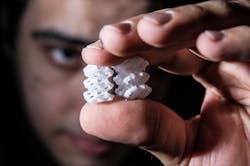Modified laser cutter prints 3D objects for biomaterials fabrication
| Unlike most commercial SLS platforms, Rice University’s OpenSLS allows researchers to work with their own powdered materials, including specialized biomaterials like polycaprolactone (PCL), a common nontoxic polymer that was used to print these tissue-engineering scaffolds. Researcher Ian Kinstlinger discovered a method for smoothing the surfaces (left) of newly printed scaffolds (right) using vaporized solvent. (Photo by Jeff Fitlow/Rice University) |
Bioengineering researchers at Rice University (Houston, TX) have modified a commercial-grade carbon dioxide (CO2) laser cutter to create OpenSLS, an open-source, selective laser-sintering (SLS) platform that can print intricate 3D objects from powdered plastics and biomaterials. The system costs at least 40 times less than its commercial counterparts and allows researchers to work with their own specialized powdered materials.1
OpenSLS, which was built using low-cost, open-source microcontrollers, cost less than $10,000 to build; commercial SLS platforms typically start around $400,000 and can cost up to $1 million.
"SLS technology has been around for more than 20 years, and it’s one of the only technologies for 3D printing that has the ability to form objects with dramatic overhangs and bifurcations," says study coauthor Jordan Miller, an assistant professor of bioengineering at Rice who specializes in using 3D printing for tissue engineering and regenerative medicine. "SLS technology is perfect for creating some of the complex shapes we use in our work, like the vascular networks of the liver and other organs."
Software shared via Github
The team showed that the machine could print a series of intricate objects from both nylon powder and from polycaprolactone (PCL), a nontoxic polymer that’s commonly used to make templates for studies on engineered bone. All the hardware designs and software modifications are open-sourced and shared via Github, notes study coauthor Ian Kinstlinger.
Kinstlinger developed an efficient way to smooth the rough surfaces of PCL objects that came out of the printer. He found that exposing the parts to solvent vapor for short time periods (around 5 minutes) provided a very smooth surface, due to surface-tension effects. In tests using human bone marrow stromal cells (the type of adult stem cells that can differentiate to form bone, skin, blood vessels and other tissues), Kinstlinger found that the vapor-smoothed PCL structures worked well as templates for engineered tissues that have some of the same properties as natural bone.
Source: http://news.rice.edu/2016/02/22/modified-laser-cutter-prints-3-d-objects-from-powder-2/
REFERENCE:
1. an S. Kinstlinger et al., PLOS ONE (2016); http://dx.doi.org/10.1371/journal.pone.0147399
